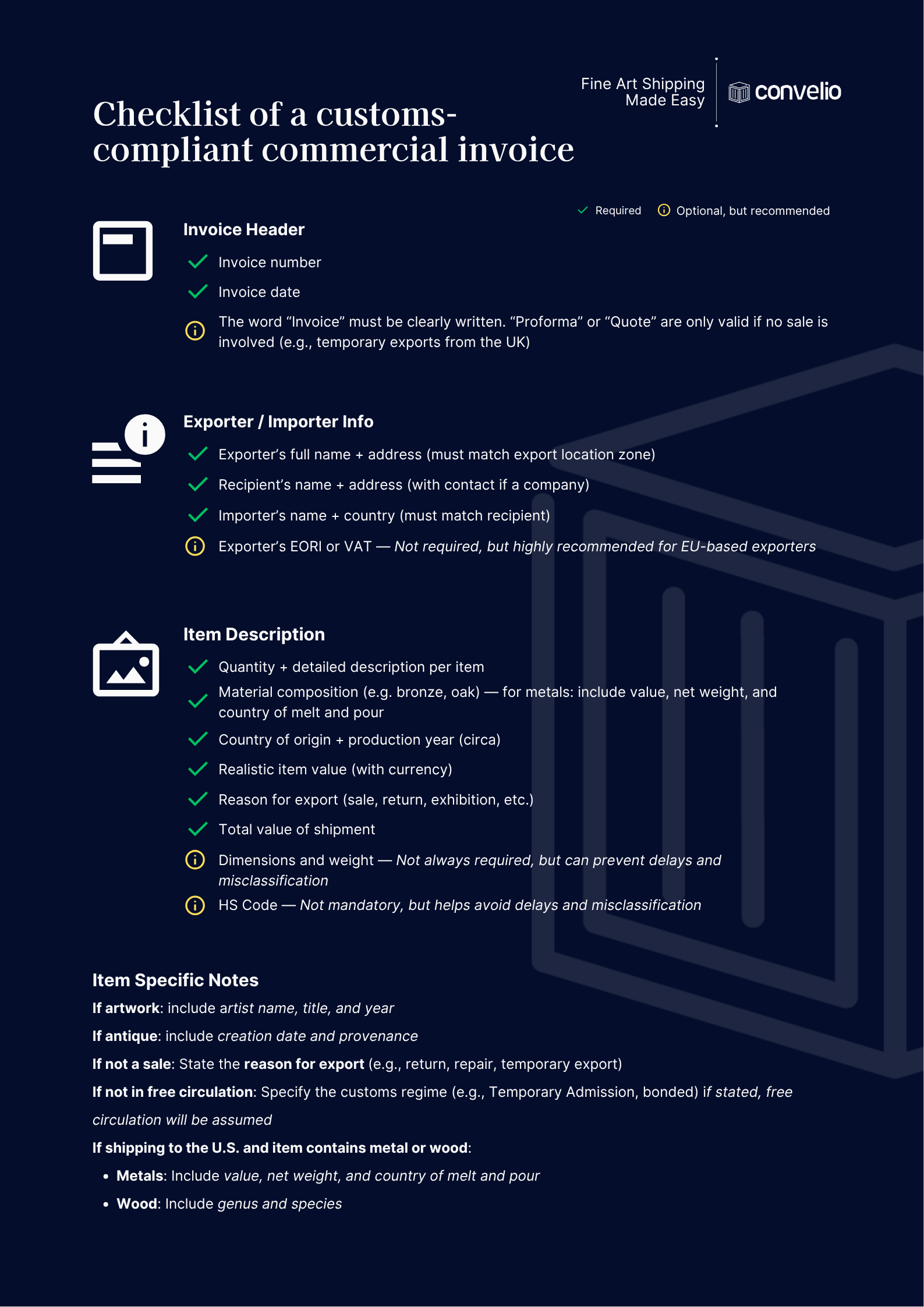What is a customs-compliant commercial invoice?
A Commercial invoice is a legal document that certifies a sale between a seller and a buyer. It defines the terms of the sale, the exact amount to be paid and the payment terms.
For an international shipment, your invoice should be written in English. Use the checklist below to make sure your invoice contains everything needed for smooth customs clearance and a quicker processing of your shipment.
Depending on several factors (shipping route, typology of item…), you may be asked to provide additional information for customs purposes:
Who is the exporter?
The exporter is the person or company sending the goods. This is typically the seller (e.g. gallery, artist, or dealer). Note that as a freight forwarder, Convelio can’t act as the exporter on behalf of the seller or sender. The exporter’s country must match the customs zone of the shipment’s departure point.
Example: You can’t use an exporter based in the UK for a shipment leaving from France (EU customs zone).
Why is the EORI or VAT number important?
While optional, including the exporter’s EORI or VAT number (especially within the EU) helps customs authorities process the declaration faster. EORI numbers begin with a 2-letter country code and are required for all businesses carrying out customs transactions in the EU.
What’s the difference between the importer and the recipient?
The recipient is the person or business physically receiving the shipment. For example, this can be a warehouse. The importer (also called “importer of record” or “consignee”) is the person or entity legally responsible for clearing goods through customs and paying duties or taxes. The importer is essentially the buyer of the goods. In most cases, the importer and recipient are the same, and their countries must match.
What is an HS code?
The HS (Harmonized System) code is a standardized 6-digit number used by customs to classify goods and determine applicable duties, restrictions, or licenses.
Example: Paintings typically fall under HS code 9701.10.
Why do I need to include materials?
Material details (e.g. sculpture in bronze, table in oak wood) help determine the correct HS code and flag any special documentation requirements (e.g. CITES permits for ivory or exotic woods).
If your item is being shipped to the US, please note a few specific requirements: – For items containing wood, the type of wood must be specified on the invoice, including its genus and species. – For items containing metal, be sure to include the metal’s value, net weight, and country of melt and pour.
Can I declare a symbolic or zero value?
No. Even if the shipment is not for sale, the declared value must be realistic and defensible. Customs will reject symbolic, “gift,” or €0 declarations.
What counts as a valid reason for export?
Examples include Sale (commercial transaction), Exhibition (not for sale), Return to owner, Restoration or repair, Temporary export…
The reason must be clearly stated on the invoice, especially for non-sale exports.
Do I need to list shipping costs in my invoice?
If shipping is included in the invoice total, it must appear as a separate line item below the goods.
When are export licenses required?
Export licenses may be needed for cultural property, antiques, or restricted materials, depending on the item's value, age, and the export country. If you already know that an export license applies, it’s always best to mention it from the start so we can plan accordingly. We’ll also flag it if needed once we’ve reviewed your shipment details.

